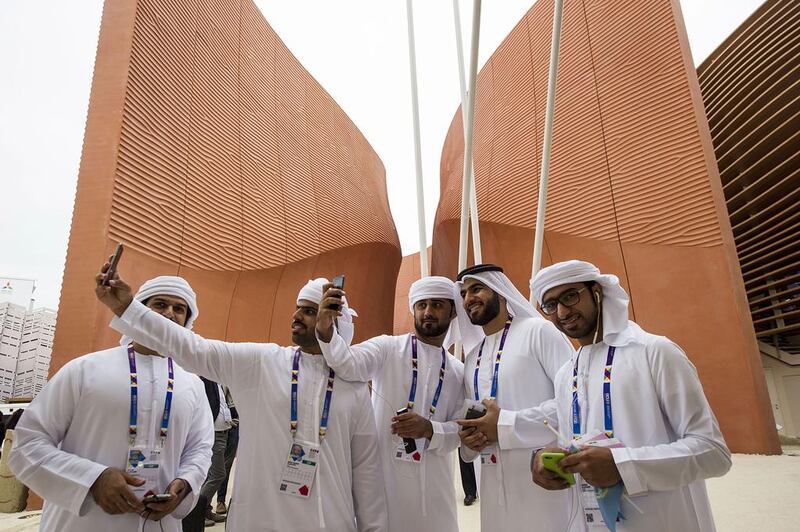MILAN // Emirati volunteers lined the entrance to the UAE pavilion on Friday as Milan Expo 2015 opened, welcoming visitors with a stunning audiovisual perspective on a young country’s history.
The pavilion, shaped like shimmering sand dunes surrounded by native plants, quickly attracted the attention of camera-wielding tourists.
Staff members arrived as early as 2am to put the finishing touches to the pavilion in anticipation of the thousands who turned out for the opening day of the six-month-long event, which is expected to attract 20 million visitors.
Lessons learnt in Milan will be put to good use when Dubai hosts its expo in 2020.
Sheikh Ahmed bin Saeed, the chairman of Emirates Airline, was the guest of honour at the pavilion, where a VIP lounge staffed by Emirates employees is one of many the highlights.
Dr Peter Vine, pavilion project director, said: “We wanted to break the mould of previous expos. What we want is for the visitors to say ‘we didn’t realise the UAE was like that’.”
Dr Vine is a veteran of UAE pavilions at expos in Yeosu, South Korea, Shanghai, China, and Zaragoza, in Spain.
The pavilion provided visitors, he said, with “revelation” and tied in with the expo’s slogan of Feeding the Planet, Energy for Life, it aimed to “give a very strong message that individuals can make a difference”.
Volunteers explained the challenges the UAE faces and told guests the Emirates receive about 100 millimetres of rain a year compared to 944mm for Milan.
The pavilion also shows how the UAE benefits from its desert climate, with the Future Business UAE section featuring a model of Mohammed bin Rashid Al Maktoum Solar Park, which is based in Seih Al Dahal, Dubai.
Dr Vine highlighted the audiovisual technology at the pavilion, which includes a short film, A Family Tree, about the life of a palm tree and how it ties in with a family’s history and the UAE’s development, as well as a virtual presentation – and a rap-style song – by an Emirati girl.
“The technologies we’re using weren’t available in 2010,” said Dr Vine, drawing comparison with the UAE’s prize-winning pavilion at Shanghai that year.
“In terms of the shows, it’s really cutting edge … we’re very pleased with the result.”
The UAE’s traditions are illustrated by The Secret Life of Date Palms, a presentation that details 7,000 years of cultivation.
Sam Barclay from Case Design, which curated the exhibit along with Dubai-based Cultural Engineering, said: “From me, coming from outside the region, what I thought was important was that if people recognise the value of this species, it can be comparable to places where they come from – native Americans with bison, Japan with whaling – and [help them] understand and recognise these resources are a valuable thing that transcends any one culture,” he said.
About 100 people, including students, helped to produce the date palm exhibit, which featured succulent dates for visitors to enjoy.
The pavilion is also catering to the taste buds of visitors with a team of chefs from the UAE.
“We show them the natural foods, how they’re producing them in their homes,” said a member of the culinary team.
Among the appetising sweets the chefs made on Friday were balls of batter fried in oil, known as luqaimat, and the breakfast favourite khabees, produced from flour and oil.
A key feature of the pavilion is the team of young Emirati volunteers from the organisation Takatof, who are helping to greet visitors. There were 10 on-hand as the pavilion opened, with a further 20 expected last night.
Once the expo in Milan is over, the UAE pavilion will be dismantled and rebuilt in Masdar City, on the outskirts of Abu Dhabi.







